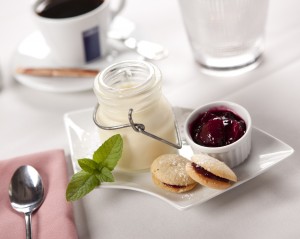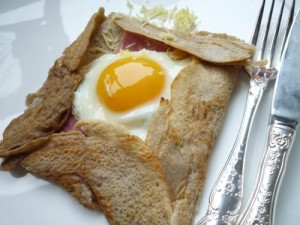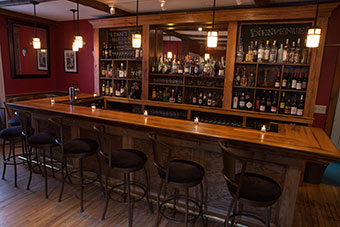I can’t wait to thank one of my favorite wine-loving guests for this book that I’m finishing up right now, by Sergio Esposito, famed NY Italian wine merchant. It’s a fantastic read and it contains, among other wonderful things, by far the best clarification I’ve ever read as to why you want to drink “organic” wine.
We once were hosting a party at the restaurant, serving two white wines. One was our house Chardonnay, which is an extremely pleasant Burgundy from a small producer, and the other was one of my favorite whites, an excellent deal called “Evolution,” from Sokol-Blosser in Oregon. It’s a blend of nine white grapes which literally dances on the tongue: it’s delicious, pure and balanced, and happens to be made by a woman who is, along with being a very high-end Oregon Pinot Noir producer, a passionate advocate of organic and sustainable viticulture. At this party, one gentleman approached the bar for a glass of white wine for his wife. After I told him the two choices (” French Chardonnay or an Organic blend from Oregon?”) he replied, “the chardonnay; my wife won’t drink organic wine, it’s bad.” What could I say? First lesson in sales, the customer is always right, and it’s not my place to contradict. But I was so sad. The other wine is not bad, but the Evolution is really something special. How to help people understand organic, biodynamic and sustainable wines better??
Now, I write “organic” because it’s so hard to categorize wine production by one label, and many organic wines aren’t even labeled as such (see above if you’re surprised, even the Evolution isn’t labeled organic though she drives her tractors on biodiesel!!). But it’s true that just as in the food world, organic can be pretty hard to define. There are other terms, like “sustainable” “minimal intervention” “biodynamic” “salmon-safe,” and it gets pretty complicated. I guess I’m just happy when I’m choosing wines for my list if I know that the grape-grower/wine-maker is paying attention to tradition, respect for the land, respect for the consumer, and if their goal is for the wine in the glass to be a conscienciously-made, pure expression of the grapes, without flavor additives, pesiticides, or other chemicals getting in the mix.
Now here’s where our friend Sergio Esposito comes in to help us understand the goal of organic viticulture. Of course I recommend reading the book, but I’ll just quote here some of what he says and see if anyone wants to argue with me. It takes a kind of devotion and commitment to make wine this way; Esposito describes “This courage of conviction — the determination to make a drink that directly contradicts convention because you believe in its unerring and morally necessary authenticity…” I would love people to come around to thinking that it’s certainly worth trying these wines…at least give them a taste! There may be plenty of bad organic wine out there, but there’s plenty of other bad wines out there too, no??? Esposito quotes one winemaker, describing the process of producing biodynamic wines:
“What is wine?…Wine is a family of bacteria, which together make life. This life — in the form of thousands and billions of fermentations — takes a simple grape to a wine. In every berry, we have everything a wine needs to develop….there are more than a thousand things you can legally add into your production process. You can add drugged-up yeasts and banana flavor if you want…. If the thing that makes a wine unique is its terroir, then the wine must taste like the earth from which it came….if you work in real agriculture, things are unpredictable. You can’t send your e-mail with the exact day of bottling…If you need to work in this chemical way, maybe you’ll one day…be really happy but your wine will be soulless, and why did you become a winemaker in the first place?”
Though my reduction simplifies things a bit far, it gives a good idea of the direction of the discussion and the details included in the book are eye-opening and exciting.
About two-thirds of our list is made by producers who are committed to making their wines in a radically clean, conscious, “organic” way…I’d love some day for it to be the whole list, and I think it can be. Too many people are changing their ways, going back to traditional methods, and seeing fantastic results. At a certain point, labels aren’t useful…we’ll let the wines speak for themselves.






